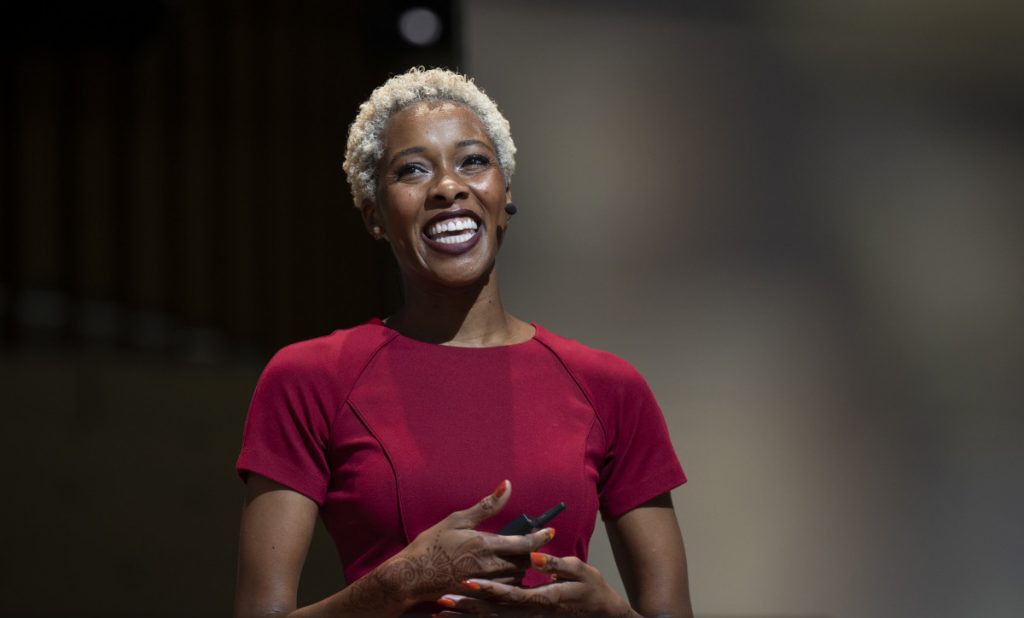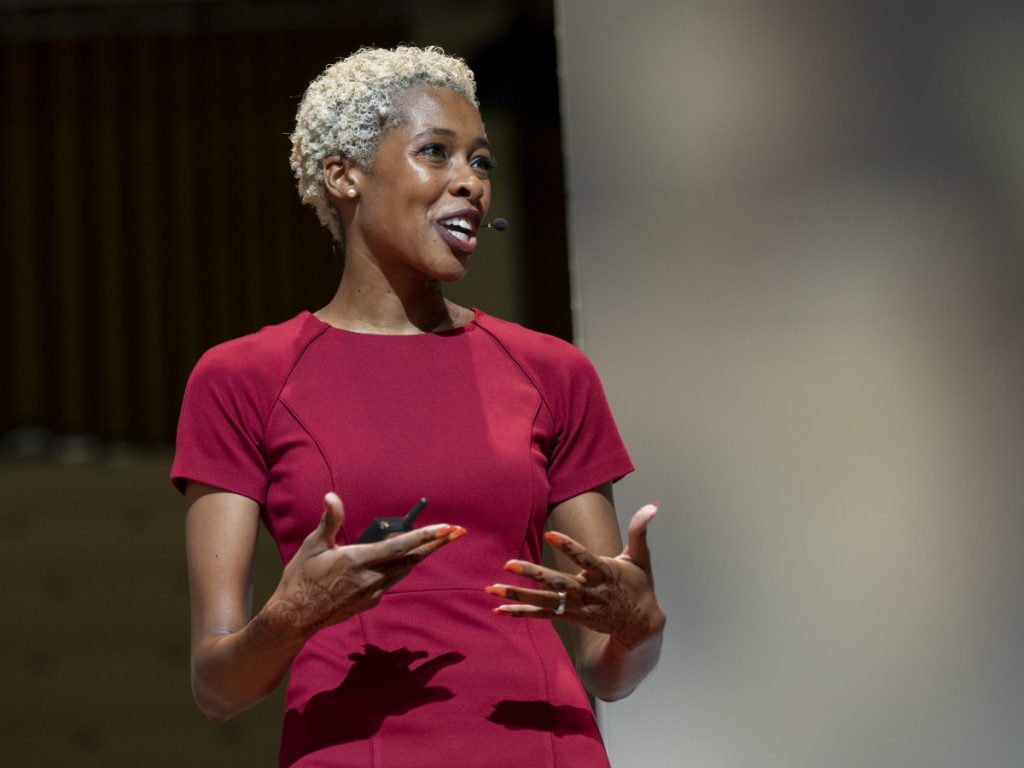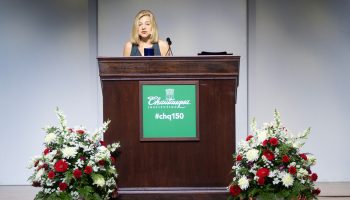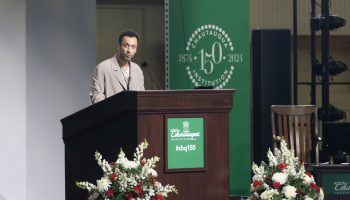NICK DANLAG – STAFF WRITER

During World War II, the Netherlands faced nine months of starvation because the country decided to protest the transport of Nazi troops. The country’s future children would face a strange phenomenon: higher rates of metabolic issues like hypertension and diabetes.
“If there is no food, something like diabetes is actually adaptive. It’s beneficial. You’re able to hold onto the sugar that you are taking in, but when we’re living in the land of plenty, that’s when it becomes a problem,” said Bianca Jones Marlin. “So scientists started to see this emergence of a metabolic memory of the past living on (in people) who had never experienced the trauma.”
Marlin is the principal investigator at Columbia University’s Mortimer B. Zuckerman Mind Brain Behavior Institute, where she researches the mechanism of transgenerational inheritance of environmental information. At 10:30 a.m. on Wednesday in the Amphitheater, Marlin presented her lecture, titled “Nature, Nurture and the Science of Parenthood,” as part of the Chautauqua Lecture Series Week Eight’s theme of “The Human Brain: Our Greatest Mystery.” Marlin discussed her own research on oxytocin in the brains of mother and virgin mice, how fears can be passed down through generations, and what her work might entail for humans.
Human babies show their emotions by laughing and crying, and other young mammals perform the same actions, especially when signaling for care. Take mice pups, which are the subject of much of Marlin’s work. These critters become cold very quickly, so whenever they are removed from the nest, they make ultrasonic vocalizations, which humans can’t hear, for help.
“I want you to know that it’s not allowed in the Marlin Lab to abuse mice,” Marlin said. “We use mice with such care and appreciation for the life that they give to us, so we can give life to humanity.”
While mother mice are quick to bring the young pups back to the nest, mice that have not given birth, which Marlin called virgin mice, are unlikely to do so. Virgin mice are more likely to leave the pups out in the cold, or sometimes cannibalize them.

So Marlin and other researchers wanted to know why there was this difference between mother and virgin mice, and where their brains vary.
She thought oxytocin was at the center of all this. Oxytocin is released through activities like talking, eye contact and soft touch, but also during birth.
“Given we see a change in virgins to mothers, is oxytocin the magical ingredient that makes that happen?” Marlin said. “Given the first sound that a mother will hear after birth is the sound of the litter crying, is the auditory cortex, which is the area of the brain that processes sound, the area in which the magic happens?”
Every three hours for three days, Marlin would inject a virgin mouse, while under anesthesia, with oxytocin. Throughout the days, Marlin would remove a pup from the nest and place it elsewhere in the cage. What her team found was that virgin mice, who formerly did not retrieve the pups, were learning to after they were treated with oxytocin. The virgin mice would also have to be housed with mother mice for some time in order to achieve the best results.
“I think this is a very important point when we think about parenthood, network, community and support,” Marlin said. “Nature has us set up to be expert caregivers, but not on our own. There’s a learning component, and there’s a communication and society component that’s essential.”
Marlin’s team mapped the oxytocin receptors in mice brains.
“We were astounded by what we saw,” Marlin said. “We saw oxytocin receptors in the left and oxytocin receptors in the right auditory cortex. However, when we looked at them together, we noticed something. There were more oxytocin receptors in the left brain than in the right.”

Marlin said the left side of the brain had twice the amount of receptors as the right. This sent “chills” through Marlin’s research team, because this meant they found “a communication center, that also expressed oxytocin receptors that was lateralized,” like human brains.
Then they wanted to make sure this change in oxytocin in mice brains was necessary for spurring on more retrieval of pups, so they deactivated that part of the brain in mother mice for a day. Mother mice that used to retrieve pups stopped doing so, and Marlin and her team found that the area of mice’s brains that told them to retrieve the pups was, indeed, the left auditory center.
Marlin then talked about her own upbringing, and why she does her work. Her parents were foster parents, so she had many nonbiological siblings.
“When we went to bed, I would hear stories of why they were in foster care, stories of abuse, stories of neglect, stories of a broken system that had separated them from their parents when they didn’t need to be,” Marlin said, and noted her own family in the audience. “Now as an adult, I realized this is what motivated my work in parental care and parental behavior. So I thank them, and my mom is here, in the corner over there. Hi, Mom.”
Marlin’s research now focuses on how trauma in parents affects brain structures and sensory experiences in their future offspring, which is called transgenerational epigenetic inheritance.
One of her studies involved almonds. She would put male mice in a cage; one side would have the scent of almonds and produce a small electric shock on the mice’s feet, while the other side had nothing. The male mice would avoid that side of the cage, and she noticed their offspring would, too.
She ended with a quote from artist Kehinde Wiley: “We are wired to care about the needs of others. I think that is in our DNA.”

As part of the Q-and-A session, Amy Gardner, vice president of advancement and campaign director, asked Marlin if there was a difference between left- and right-handed mothers on the side of auditory perception in the brain.
“The majority of the animals, 70% of the mice, who had the quieting of the left auditory hearing centers, did not retrieve, but there was 30% that consistently did,” Marlin said. “Similarly, when we silenced the right, a large percentage of them continued retrieving, but a small percentage didn’t.”
This leads her to believe that the same could be true for humans.
Gardner asked Marlin if there was a difference between how male mice retrieved pups versus female mice.
Marlin said that while females took about 3-12 hours to start retrieving the pups after the oxytocin treatment, male mice took about three days.
Gardner then asked Marlin if there was any research done on transgenics and the impact of structural racism.
“We’re looking at a targeted approach. It’s a jump to really call a foot shock ‘trauma.’ I have all my students test the foot shocks and feel it on their hands,” Marlin said. “The mice are tested with the foot shock five times a day for three days, so 15 light foot shocks, 15 walking around on the carpet and touching a doorknob.”
But, Marlin said this could potentially change the mice’s sperm makeup and impact the second generation.
“We could just think about the chronic stressors like systemic racism and how much more that could be affecting the brain and the body,” Marlin said. “That’s a question that is scary, but important.”




